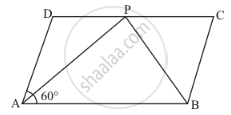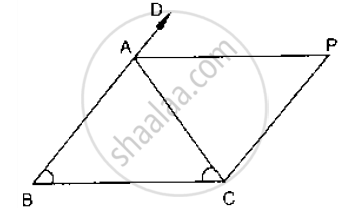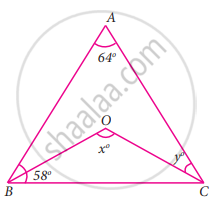Advertisements
Advertisements
Question
In a parallelogram ABCD, if `∠`B = 135°, determine the measures of its other angles .
Solution
Given `∠`B = 135°
ABCD is a parallelogram
∴`∠`A = `∠`C, `∠`B = `∠`D and `∠`A + `∠`B =180°
`∠`A + `∠`B =180°
`∠`A = 45°
⇒ `∠`A = `∠`C = 45° and `∠`B = `∠`C =135°
APPEARS IN
RELATED QUESTIONS
In Fig., below, ABCD is a parallelogram in which ∠A = 60°. If the bisectors of ∠A and ∠B meet at P, prove that AD = DP, PC = BC and DC = 2AD.

ABCD is a square. AC and BD intersect at O. State the measure of ∠AOB.
P and Q are the points of trisection of the diagonal BD of a parallelogram AB Prove that CQ is parallel to AP. Prove also that AC bisects PQ.
In Fig. below, AB = AC and CP || BA and AP is the bisector of exterior ∠CAD of ΔABC.
Prove that (i) ∠PAC = ∠BCA (ii) ABCP is a parallelogram

In a parallelogram ABCD, if ∠A = (3x − 20)°, ∠B = (y + 15)°, ∠C = (x + 40)°, then find the values of xand y.
In a parallelogram ABCD, the bisector of ∠A also bisects BC at X. Find AB : AD.
We get a rhombus by joining the mid-points of the sides of a
The figure formed by joining the mid-points of the adjacent sides of a rhombus is a
In the given figure, ∠A = 64°, ∠ABC = 58°. If BO and CO are the bisectors of ∠ABC and ∠ACB respectively of ΔABC, find x° and y°
Prove that the quadrilateral formed by the bisectors of the angles of a parallelogram is a rectangle.
